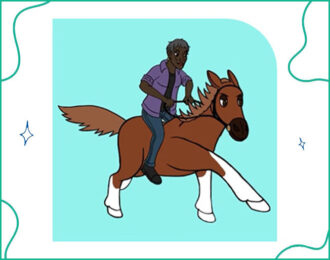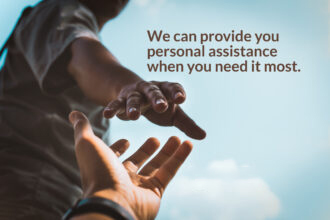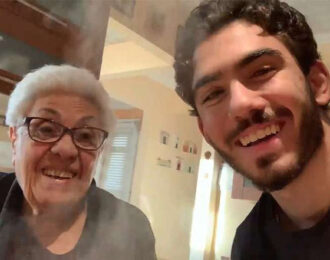Ready to Give Meditation a Try?

A beginner’s guide to quieting the mind in a time of stress
by Kimberly Goad, AARP, April 21, 2020
En español | If you’ve always been interested in — if a bit daunted by — the idea of meditating, now might be the perfect time to forge ahead with the practice. Research shows that cutting through the mental static and focusing your mind this way helps alleviate stress and anxiety, slows aging, improves your attention span — and can even act as a sleep aid. And who doesn’t need help with all of the above right now?
That said, for something so simple (what’s more straightforward than, say, concentrating on your own breath?), meditation can take effort. Sitting still, as is often involved, isn’t necessarily as easy as it sounds. And try to focus on a singular phrase or idea can be tedious for minds used to wandering at will. And then there’s the need to sort out what exactly, you’re even trying to do.
“People often think meditation is about getting rid of thoughts or feelings, which it’s not,” says Sharon Salzberg, cofounder of the Insight Meditation Society, and author of Real Happiness: The Power of Meditation and the forthcoming Real Change: Mindfulness to Heal Ourselves and the World. “Or they think it’s about having only beautiful thoughts or peaceful states, which it’s also not. Meditation is about developing a different relationship with our thoughts.”
Say, for instance, you’ve been taking in a steady stream of news. Your mind — no surprise — becomes fixed on all the many what-ifs, such as: What if life never returns to normal? Meditation, a form of mindfulness, allows you “to see what’s happening right now without distorting it,” Salzberg says. “It’s not that difficult things don’t arise; they do. But we don’t have to add to them. With mindfulness we learn to feel a whole range of emotions and physical sensations without getting swept up in them — or trying to push them away.”
Tips for getting started
The guided meditations that follow are designed to help with all of that. Before you begin, keep the following pointers in mind.
- You don’t have to meditate for hours. Benefits appear pretty fast. In a study published in Psychoneuroendocrinology, participants who meditated just 25 minutes a day for three days reduced their levels of stress. That said, you will need to build up your own stamina. Aim for five minutes a day for two weeks and gradually work up to longer. Set the timer on your phone or follow a short meditation on an app.
- When and where are up to you. “Morning could be good because it sets the stage for the rest of your day,” Salzberg says. “Some people meditate at night because it helps them sleep better. Think about what’s realistic for you. Back in the days when people were driving to work, someone told me they’d go to work early, then sit in the parking lot and meditate.”
- Choose something specific to focus on. It can be your breath, a saying or “mantra” that you repeat, or something you can fix your gaze on. “If you’re anxious, pay attention to your feet because your feet are an anxiety-free zone,” suggests Jud Brewer, M.D., director of research and innovation at the Brown University Mindfulness Center and associate professor of psychiatry at Brown’s medical school. Next, Brewer instructs to ask yourself simple questions about what you’re focusing on, such as “Which foot feels warmer … or tingly-er right now?” As he explains, it doesn’t matter at all which foot feels what, but asking the questions “awakens our natural capacity to be curious, and curiosity is really key here.”
- There’s no right or wrong way to meditate. You don’t have to perch pretzel-like on a cushion if that isn’t comfortable. Try simply sitting with your legs and arms uncrossed, your arms resting on your legs and feet on the floor so that you feel grounded, advises Megan Jones Bell, chief science officer at Headspace, a digital health company that provides guided meditation training. “Remember, the goal is to feel relaxed, comfortable and focused.”
- Your mind will wander. And that’s OK. “One of the biggest misconceptions of meditation is that it has to be done correctly 100 percent of the time,” Bell says. “The truth is, it just doesn’t happen like that immediately. The idea of meditation is to sit and be comfortable with our mind as it is. Sometimes the mind is busy. Sometimes it’s quiet. But over time, as we get better at this, the mind naturally starts to settle down.”
- Mini meditations count, too. Before you hit “send” on an email, take three deep breaths. When you get a phone call, let it ring three times — long enough for a deep breath — before picking it up. Or resolve to fully be in the moment when you do a simple, pleasurable ritual such as drinking a cup of tea. What does that mean, exactly? No watching TV or checking your email at the same time, for starters. The idea is to really focus on what you’re doing, Salzberg says, “so you can smell the tea, taste the tea, feel the warmth of the teacup.”
3 Guided Meditations to Try Now
Jud Brewer’s Meditation for Anxiety
Find a quiet, comfortable place. You can be sitting, lying down or even standing up. You just need to be able to concentrate without being too distracted.
Begin by simply taking a moment to thank yourself for being here and for taking care of yourself. See what this feels like — simply giving thanks.
And if you’re feeling anxious right now or even a little stressed, let’s see how you would describe it. If you’re not feeling anxious, simply recall a recent experience when you were anxious and relive that experience to see what you felt at the time.
Take a moment and ask yourself, what is the sensation that I feel most strongly in my body right now? Take a moment to locate where it is. Now see if you can get really curious. Do you feel it more on your right side or left side? Or, if it’s right in the middle, is it more toward the front or the back of your body?
Did you notice your mind going, Hmm, where do I feel it most strongly? This is jump-starting, or warming up, your curiosity. And if you aren’t feeling curious, you can simply hit the pause button right now and take a moment to be curious about why you aren’t curious. What does not being curious feel like?
Now let’s take this one step further. Check in again with your body and see where that anxious feeling is strongest right now. Now imagine slowly breathing in through your nose and right into that body part. Let that breath go right into your anxiety and hold it there for a few seconds before letting your breath go out.
Let’s do this again. Take a slow, deep breath, imagining that kind, curious breath going right into your anxiety. Let your breath hold that feeling of anxiety for a second in a warm, kind embrace. And then breathe out — let it go. See how much of that anxiety releases with your breath.
And, again, on the next breath in, bring curiosity to that anxiety. What do the physical sensations feel like right now? Have they changed at all? And, continuing with this practice, one breath at a time at your own pace, breathe kindness and curiosity right into those physical sensations. Hold them there for a moment and then, on the out breath, let them go.
You can continue doing this breathing exercise now or any time throughout the day for a few seconds, anytime you feel anxiety coming on. See what happens as you keep practicing it. And don’t forget that attitude of kindness and curiosity. These are key.
Sharon Salzberg’s Meditation on Loving-Kindness
It’s good to be comfortable, either sitting or lying down. You can close your eyes or not. And begin the offering of loving-kindness to yourself:
May I be safe, be happy, be healthy, live with ease.
Repeat the phrases with enough space and enough silence so that it’s pleasing to you. Gather all of your attention behind one phrase at a time. If you find your attention wandering, don’t worry about it. Simply let go and begin again.
May I be safe, be happy, be healthy, live with ease.
Feelings may come and go; memories may come and go. Allow them to arise and pass away. The touchstone is the repetition of the phrases. You don’t have to block anything else and you don’t have to follow after it.
May I be safe, be happy, be healthy, live with ease.
Call to mind someone who’s helped you. They’ve been good to you, kind to you, or maybe you’ve never met them, but they’ve inspired you. If someone like that comes to mind, bring them here. You can get an image of them, say their name to yourself, get a feeling for their presence, and offer the phrases of loving kindness to them. Wish for them just what you’ve wished for yourself.
May you be safe, be happy, be healthy, live with ease.
Even if the words don’t fit totally, it doesn’t matter. They’re the conduits of your heart, the vehicle for connection.
May you be safe, be happy, be healthy, live with ease.
You can let thoughts, emotions, and memories arise and pass away without clinging to them, without condemning them. Maybe you have the thought, What does she need me for, she’s so great? or What does he need me for, he’s so great? Just let it come and go.
Your attention can steady on the repetition of the phrases — and a friend, the first friend who comes to mind.
May you be safe, be happy, be healthy, live with ease.
Call to mind someone you know who’s hurting, who’s having a difficult time right now. Bring them here. You can get an image of them, say their name to yourself, get a feeling for their presence, and offer the phrase of loving-kindness to them.
May you be safe, be happy, be healthy, live with ease.
If you find your attention wandering, you needn’t be discouraged, just gently let go, and come back, one phrase at a time.
And then to all beings everywhere, all people, all creatures, all those in existence, known and unknown, near and far.
May all beings be safe, be happy, be healthy, live with ease.
And then to the boundlessness of life itself.
May all beings be safe, be happy, be healthy, live with ease.
And when you feel ready, you can open your eyes. Pay attention throughout the day to see how this meditation may be having an effect.
Headspace Cofounder Andy Puddicombe’s Meditation for Sleep
Take a moment to get comfortable, lying in your bed or wherever it is you want to fall asleep. Make sure you’re under the covers in case you do fall asleep. And even if you don’t usually sleep on your back, begin the exercise by lying flat on the bed, with your knees slightly bent, and just enjoying that feeling of the body letting go, relaxing, sinking into the bed beneath you.
As you lie there, take one or two nice deep breaths, breathing in through the nose and out through the mouth. If you find it comforting, you can place your hands on your stomach, to feel the movement of breath in the body.
As you lie there, notice how the body feels — whether it feels heavy or light, restless or still, ready for sleep, or is there still a little bit of winding down to do? Either way, we’re just going to go through this exercise slowly, pointing the body and the mind in the direction of sleep.
Begin by just thinking back to the very first part of the day. It’s almost as though you’re watching a video fast-forwarding through the day and you’re just touching on each of the main things. It might be as simple as thinking about getting up, having breakfast, having a shower, leaving the house, going to work. Maybe you just touch on 20 to 25 little moments throughout the day, to bring you all the way up to the present moment. Getting ready for bed and then getting into bed.
When you do this each time, for about 20 or 30 seconds, just briefly go back through the day and bring your mind all the way back up to the present moment. When you reach the present moment, take one deep breath in, and as you exhale, feel the body sinking into the bed.
Mentally, start to switch off the different muscles in the body so that the body can really start to relax and move toward sleep. Start with your feet, and it’s as though mentally you give your feet permission to switch off. All the muscles, all the nerves, just relaxing that part of the body. Then around the ankles and the lower half of the leg, just switching it off. The knees, the thighs, the backs of the legs, just switching the muscles off.
Up toward the waist and the pelvic area, again just mentally switching it all off and allowing it to go to sleep. Into the lower stomach, the lower back, just switching it off. It’s almost as though you can feel these different parts of the body move toward a more restful state. The rest of the stomach, the middle of the back, just switching it off. The chest, the upper back, switching it off. Shoulders, upper arms, switching it off. Forearms, the hands, fingers — again just switching it off.
The entire body, from the neck downward, is very heavy now. Continue with the throat and the neck, just allowing that area to go to sleep now. The jaw, the muscles in the face and the head, just switching them off until you reach the very top of the body — and the entire body is now heavy, relaxed, and ready to sleep.
If the mind feels the same, you can just allow the mind to be completely free to do what it wants to do and slowly drift off to sleep. If the mind feels active still, you can just allow the body to continue resting as it is. But mentally, slowly begin to count backward from 1,000 to zero. Go at a very steady pace, not rushing it, not trying to fall asleep. Just focus on counting from one number to the next in reverse and knowing that it really doesn’t matter too much when sleep comes. As you lie there in this way, know that both the body and the mind will get all the rest that they need.





